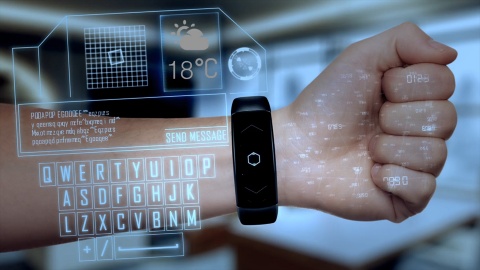
Smart cities with connected cars and autonomously flying drones, new shopping experiences, sensors everywhere, and no more smartphones: This is what the world of the Internet of Things (IoT) could look like in 2030.
Welcome in the year 2030. My name is Hannah, and I am on my way home from work at the Cybersecurity Center. There, I am committed to the highest level of security in an increasingly digitized and connected world. As an expert in IoT, I will be happy to take you on a journey to your future of the internet of things.
Although I am sitting in my car right now, I can dedicate my full attention to you. I neither have to steer, nor brake or shift, as my smart electric car takes me wherever I want to go – quickly, safely, and without engaging. Not having to pay attention to the traffic allows me to pursue my interests, such as having my most favorite novel projected onto my retina or dive into a virtual reality (VR) game. Honestly, I cannot imagine how boring life was without these games.
Nowadays, almost everyone has a gaming console at home. However, it does not look like one of your typical Playstation consoles anymore. It consists of goggles and a couch that can be turned in all different directions. We players meet in giant 3D worlds and experience various kinds of adventure. My favorite game currently: Jupiter Monopoly. I do not have much time to play it in the car, but I can seamlessly resume the game at home after putting on my portable VR glasses.
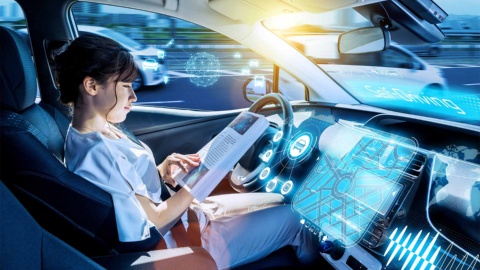
Smart City
Connected Cars in the Internet of Things
I have good news for you: In the future, there will be hardly any accidents. Sensors all around a vehicle will trace all obstacles and respond automatically. Don’t worry. At some point, you will also drive such a connected car. Almost all vehicles will be part of the Internet of Things by 2030. That means, driver’s licenses will become obsolete and driving schools will disappear as a consequence thereof. Also, gas stations and auto shops will no longer be necessary. For instance, if a car needs a tune-up, predictive maintenance will detect it and service the vehicle automatically.
Today, no one can imagine the fact that there has once been traffic jams. Today, our vehicles communicate with one another on the road. If there is a traffic jam congesting a particular road, for instance, approaching vehicles simply take a different route – all without your typical GPS navigation devices.
How the Internet of Things changes the City
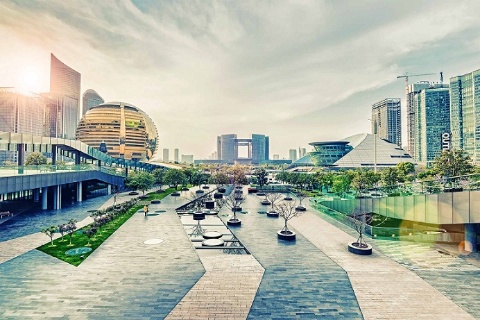
Everything has become much more efficient. We hardly need to wait in traffic anymore. Street lights with cameras and sensors analyze the location and the number of road users. Independently, they switch from red to green. Driving around the block to look for free parking? Passé! Your car will navigate you to the nearest available parking spot, as parking lots are also connected. Even in front of pedestrian crossings and schools, cars throttle their speed automatically.
Streets have also become much safer. Cameras on light posts surveil entire roads and thus immediately identify a purse snatcher, for instance. Then again, an embedded SIM in your bag card will signal its location by itself.
The smart street lights have much more to offer: Once a person or a vehicle approaches, the smart LED street lamp lights up – and vice versa. This technology saves more than half of the power traditional light bulbs consume.
Daily Life Support
The Internet of Things in Health Care
Wait a minute. My mother is calling. She is sick. She is over 80 and lives by herself. Yesterday morning, the emergency app alerted me that her health sensors measured unusual results. Via telemedical diagnosis, the computer checked all data again. I ordered a flight taxi to take her to the doctor. He already knew, because he also receives the results. Luckily, it is not as bad as expected. She only has light fever, whereupon the doctor gave her an injection. I will go visit her. We have already feared that the 3D kidney, installed two months ago, failed, but this is fortunately not the case. Today, organs, which no longer work, are replaced by artificial ones from 3D printers. Do you find this amazing? Back in the days, that is how prostheses were manufactured, while researchers worked on the development of artificial vessels. In animal experiments, scientists were even able to produce functional ovaries.
You may have already heard about flight taxis in 2017, when the test phase began. I personally remember the first attempts, when drones from Uber Elevate transported passengers in Dubai. These drones were a huge success, as they neither require a driver, nor a runway. They take off vertically and land the same way. The overloaded traffic network is thus no longer bound to two-dimensional surfaces, but takes advantage of the three-dimensional space instead. Computers program the route, and off you go. There are electric charging stations waiting for you. When I saw the recordings, I wanted to fly with it. I was 15 at that time, and I could not imagine how natural this way of flying would come one day. It is amazing to take off like that and float between skyscrapers, without any noise and exhaust fumes. Up until now, only flight taxis are allowed to maneuver in the air like that. But this could change. Scientists just need to solve the problem of how traffic could be regulated in the air. But thanks to sensors, communications networks and camera monitoring, this problem should be solved soon.
The Disappearance of Smartphones
You may wonder where your phone is? I personally don’t need a phone anymore. The last smartphone generation, the ePhone 15, was built in 2025 but sold poorly. No wonder. I remember how cumbersome it was to keep a device in my hand. Communicating, shopping, playing and gathering information via HoloLens glasses is much more intuitive. You may have already noticed that in 2017, when the first HoloLens models, still rather immature at this time, entered the market. Then, Microsoft announced the end of the smartphone and Trendone innovation researchers predicted that we would not have to produce any more devices for digital communication by 2027 at the latest. Both were right.
It is also much more practical. If I want to know whether or not I still have broccoli at home, I ask my HoloLens via voice control. I have the option to use it as glasses or as a smart contact lens. Either way, she tells me the result – and if I agree, the vegetable go right onto my virtual shopping list, which directly reports to the grocery store.
How IoT makes Life easier
You know what? I feel much better, despite worrying about my mother. The cheerful music has helped. My smart bracelet played the hottest summer hit. Title: "What a hard life it was in 2017". The bracelet not only measures my blood glucose, pulse and blood pressure, but also my mood. If it detects stress or grief, it responds by playing music or reminding me of the good old days. Speaking of it, I could go to a coffee bar, where nothing has changed. Or I could go shopping. That's a good idea.

Trust me! Life in 2030 is much easier. Everything is connected. According to the IT research firm Gartner, there were eight billion connected devices in 2017. In 2025, IBM reported 75 billion devices. Today, there are no more devices that are not connected via Internet. This saves a lot of time because information is automatically passed on from device to device. Strictly speaking, data automatically knows where to go to be processed.
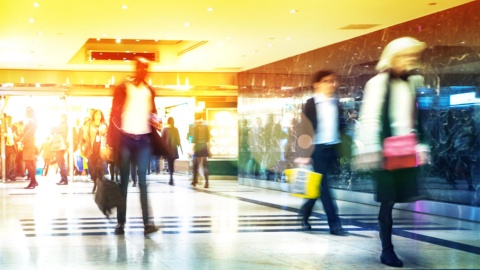
Shopping of the Future
Do you want me to show you how to shop in the future? Look, on the dashboard screen of the shop, which we are about to pass, an offer is flashing. This is tailored to my needs: I have bought wine there before, and now my favorite brand "2023 Cabernet Blanc Finlandia" is on sale. During your time, shops experimented with this type of customer loyalty – but you had to use cumbersome apps to be notified. Today, this is much easier and more seamless: Sensors, RFID technology and NFC chips make it possible.
Wine and cheese: That is all I need today. You will see, even paying is easier. I just have to stop at the exit where the system scans the chips or RFID on the products automatically. Vendors no longer have to interact. I pay via NFC chip built into my bracelet. I simply hold it up against a terminal and confirm my purchase via personal code – in a few seconds, I will be done.
Smart clothes, smart shelves
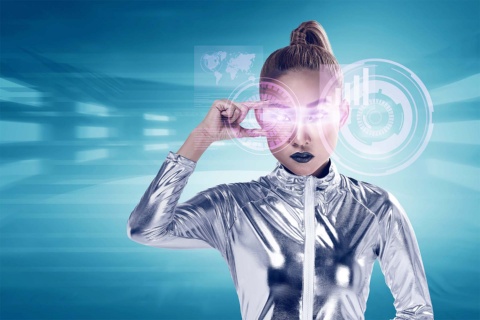
There is a boutique next door. I think I will try on one of these smart jogging shirts. This analyzes the environment and reads my body measurement: If I am cold, it warms me up. The mirrors in the dressing room tell me that this model is still available in three different colors and where it was made. Via voice command, I get even more information.
Empty shelves no longer exist because they have become smart. They sense when they need to be replenished, while robots restock them. Devices act autonomously and communicate with each other. During your time, there were first attempts: Algorithms predicted when individual products were sold out and ordered new deliveries.
So, here is where I live: Snowden Drive 220a. I will just take the purchases inside. On my way over, I alerted the home security system, telling it when I will arrive, so it switches on the lights for me. The coffee machine has brewed me a Maccacino, just the way I like it – over time and based on my feedback, the machine has come to know my taste and adapted it. And the machine knows my voice – the coffee for my sister is prepared quite differently. You already know that we do not need to touch-based control devices anymore. You already witnessed the breakthrough of voice controlled assistants, such as Apple’s Siri or Amazon’s Alexa. Even today, voice control plays an important role, but there is more to it. Devices can analyze our gestures by using radar technology. Google's research project Soli, which was launched in 2015, paved the way. Today, the gesture control comes natural – for example, when changing the TV channel in your Smart Home.
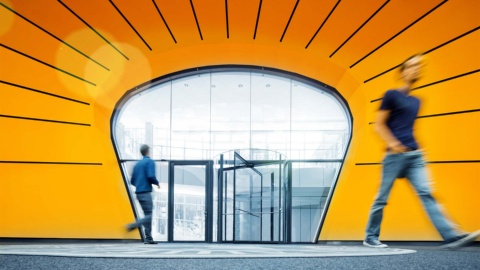
The Biggest IoT Risks in 2030
Sorry, but I will have to say goodbye to you now. I still need to check on my mother. I would have liked to tell you more about your future. What do you say so far? Are you stunned by what is going to happen? I hope I have not romanticized too much. Of course, everything has its downside. Sure, now everything works incredibly efficiently. And the world has become safer – if there were no attackers. Since everything is connected these days, we have become more vulnerable. Giant cybersecurity centers always try to be a step ahead of potential attackers. I myself work on new security technologies that are supposed to protect us – and they are usually successful. Chips with built-in security, encryption, and authentication technology cannot be tricked by attackers. Yet, this is not the only challenge.
Today, people have too much time, which is not a problem per se, but it does entail negative side effects. As early as 2017, the Israeli futurologist researcher and best-selling author of "Home Deus", Yuval Noah Harari, warned: "Most people will no longer be needed for business. They will become obsolete.” This is due to the fact that highly specialized experts are in demand. Everything else is done by robots and machines – and they are faster and cheaper than humans. Many had to adjust to this change. The problem was the lack of perspective that arose from it. Making decisions is also hard for many people. They are simply no longer used to it. Harari puts it as follows: "We delegate them to algorithms." We asked Google for directions, Siri for information and Alexa for our choice of music.
Yuval Noah Harari's gloomy prophecy at the time: "The real problem will be to make people's lives meaningful in the future." You asked, if I agree with that? No. For me, this is not true. I have more time for my biggest hobby: VR games. Unfortunately, I have no more time for you now. My taxi is here. See you next time. We will talk again!
Last update: October 2017
